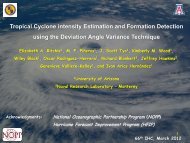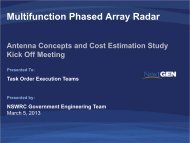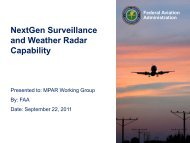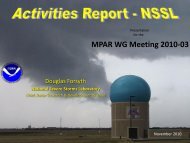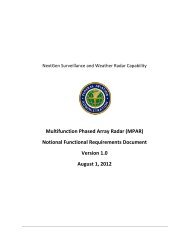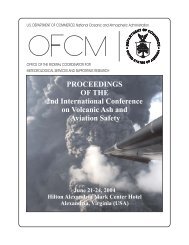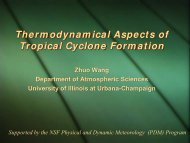Multifunction Phased Array Radar (MPAR) Automatic Dependent ...
Multifunction Phased Array Radar (MPAR) Automatic Dependent ...
Multifunction Phased Array Radar (MPAR) Automatic Dependent ...
Create successful ePaper yourself
Turn your PDF publications into a flip-book with our unique Google optimized e-Paper software.
Figure 3 shows the terrain coverage at 18,000’ for the en route <strong>MPAR</strong>s for various<br />
ranges. It can be seen from the figure that 120 nm spacing is adequate for en route<br />
surveillance, and requires a modest number of 155 sensors.<br />
Figure 3. En Route <strong>MPAR</strong> terrain coverage at 18,000’ for different ranges.<br />
<strong>Phased</strong>-<strong>Array</strong> Elements<br />
The next consideration in the study was the power per phased-array element and the total<br />
number of elements required. Figure 4 shows the aircraft surveillance range vs power per<br />
element for en route and terminal <strong>MPAR</strong>s for various beam widths. It can be seen from<br />
the figure that 2 W per element for En Route <strong>MPAR</strong> surveillance (1° beam, 120 nm<br />
range) and 5 W per element for Terminal <strong>MPAR</strong> surveillance (2° beam, 60 nm range)<br />
meet the design requirements.<br />
Figure 5 shows an example of one possible tradeoff between element power and weather<br />
sensitivity. In this example, the minimum detectable weather signal in dBZ is shown vs<br />
range for NEXRAD, en route <strong>MPAR</strong>, TDWR and terminal <strong>MPAR</strong>. In the case of the<br />
<strong>MPAR</strong> designs, it is necessary to employ short uncompressed pulses at short range to get<br />
the necessary range resolution and longer compressed pulses at longer ranges to get the<br />
necessary sensitivity. The transition between uncompressed and compressed pulses<br />
occurs at the discontinuity in minimum detectable signal in each case. For this example,<br />
the en route <strong>MPAR</strong> requires 2.5 W per element for a 1° beam and the terminal <strong>MPAR</strong><br />
requires 10 W per element for a 2° beam. These beam widths correspond to 20,000<br />
elements per face for en route <strong>MPAR</strong> and 5,000 elements per face for terminal <strong>MPAR</strong>.<br />
4



